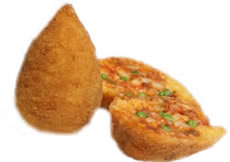Makes 10 cups, or six main dish servings.
 During the late 17th century, the Dutch system of producing these cast metal cooking vessels was more advanced than the English system. The Dutch used dry sand to make their molds, giving their pots a smoother surface. Consequently, metal cooking vessels produced in the Netherlands were imported into Britain. In 1704, an Englishman named Abraham Darby decided to go to The Netherlands to observe the Dutch system for making these cooking vessels.
During the late 17th century, the Dutch system of producing these cast metal cooking vessels was more advanced than the English system. The Dutch used dry sand to make their molds, giving their pots a smoother surface. Consequently, metal cooking vessels produced in the Netherlands were imported into Britain. In 1704, an Englishman named Abraham Darby decided to go to The Netherlands to observe the Dutch system for making these cooking vessels. Four years later, back in England, Darby patented a casting procedure similar to the Dutch process and began to produce cast-metal cooking vessels for Britain and her new American colonies. It is possible that because Darby’s patent was based upon his research into the Dutch foundry system that the cooking vessels he produced came to be referred to as “Dutch” ovens.Other researchers believe that this term may have come from the itinerant Dutch traders who sold cooking vessels out of their wagons as they traveled from town to town and door to door. In any event, the term “Dutch oven” has endured for over 300 years, since at least 1710.
Four years later, back in England, Darby patented a casting procedure similar to the Dutch process and began to produce cast-metal cooking vessels for Britain and her new American colonies. It is possible that because Darby’s patent was based upon his research into the Dutch foundry system that the cooking vessels he produced came to be referred to as “Dutch” ovens.Other researchers believe that this term may have come from the itinerant Dutch traders who sold cooking vessels out of their wagons as they traveled from town to town and door to door. In any event, the term “Dutch oven” has endured for over 300 years, since at least 1710. Over time, the Dutch oven used in the American colonies began to change. The pot became shallower and legs were added to hold the oven above the coals. A flange was added to the lid to keep the coals on the lid and out of the food.
Over time, the Dutch oven used in the American colonies began to change. The pot became shallower and legs were added to hold the oven above the coals. A flange was added to the lid to keep the coals on the lid and out of the food.The cast-iron cookware was loved by colonists and settlers because of its versatility and durability. It could be used for boiling, baking, stews, frying, roasting, and just about any other use. The ovens were so valuable that wills in the 18th and 19th centuries frequently spelled out the desired inheritor of the cast iron cookware. For example, Mary Ball Washington (mother of President George Washington) specified in her will, dated 20 May 1788, that one-half of her "iron kitchen furniture" should go to her grandson, Fielding Lewis, and the other half to Betty Carter, a granddaughter. Several Dutch ovens were among Mary’s “iron kitchen furniture.”
When the young American country began to spread westward across the North American continent, so did the Dutch oven. A Dutch oven was among the gear Lewis and Clark carried when they explored the great American Northwest in 1804–1806. The pioneers who settled the American West also took along their Dutch ovens. In fact, a statue raised to honor the Mormon handcart companies who entered Utah’s Salt Lake Valley in the 1850s proudly displays a Dutch oven hanging from the front of the handcart. The Dutch oven is also the official state cooking pot of Utah.
Mountain men exploring the great American frontier used Dutch ovens into the late 19th century. Dutch oven cooking was also prominent among those who took part in the western cattle drives that lasted from the mid-19th century into the early 20th century.
Types of Dutch ovens
camping, cowboy, or chuckwagon Dutch oven has three legs, a wire bail handle, and a slightly concave, rimmed lid so that coals from the cooking fire can be placed on top as well as below. This provides more uniform internal heat and lets the inside act as an oven. These ovens are typically made of bare cast iron, although some are aluminum. Dutch ovens are often used in Scouting outdoor activities.
A cast-iron Wagner dutch oven on a trivet ) and an enameled "French" oven by Le Creuset
Modern Dutch ovens designed for use on the cooktop or in the oven are typically smooth-bottomed. Two French manufacturers of enameled Dutch ovens, Le Creuset and Le Chasseur, refer to their ovens as "French ovens", or in the UK as "casserole dishes".
Some older styles, such as the unglazed ovens by Lodge, Griswold, CampChef, and Wagner, retain the bale handle, while others, such as the enameled versions by Staub, Sante, and le Creuset, have two loop handles. Modern ovens may also be made of thick cast aluminum or ceramic.
[edit] Cookware descended from Dutch Ovens Bedourie ovenMain article: Bedourie oven
In Australia, a bedourie camp oven is a steel cookpot shaped and used like a dutch oven. Named after Bedourie, Queensland, the Bedourie ovens were developed as a more robust (non-breakable) alternative to the more fragile cast iron dutch ovens
Potjiekos
A cast iron potjie on a fireIn South Africa, a potjie (pronounced /pˈɔɪkiː/), directly translated "small pot"[from Afrikaans or Dutch, is a traditional round, cast iron, three-legged (tripod) pot. It is similar in appearance to a cauldron and is usually black. It is used to cook potjiekos over an open fire.
Among the South African indigenous tribes these pots also became known as phutu pots.
"Potjie" can also refer to the technique of cooking potjiekos. This tradition originated in the Netherlands during the Siege of Leiden and was brought to South Africa by Dutch immigrants.It persisted over the years with the Voortrekkers and survives today
Written by Joe D on October 31st, 2007 
Another gem from this wonderful noir collection.
 Decoy
Decoy is a great little film, in a similar vein to Edgar G. Ulmer’s
Detour. Low budget but bursting at the seams with creativity,
Decoy was recently re-discovered by a neighbor of mine, Bill Rush, who works at Warner Brothers. It hadn’t been seen since 1970 and it’s screening at the
American Cinematheque Noir Program caused a sensation. Okay let’s begin at the beginning! A great weird opening! Close up on a battered, chipped porcelain sink, dirty hands come into frame, turn on hot water, steam blasts into the sink! Cold water will do, pan to a roll of paper towels suspended on a piece of twine, pan and tilt to a chunk of broken mirror revealing a disheveled zombie looking guy. We later find out he’s a dishonored doctor(Herbert Rudley).

Is this a Zombie Movie or a Film Noir?
He exits the gas station rest room, stumbling like the undead, ignoring the cheerful good morning patter from the pump jockey, Hitching a ride into the city. He goes into a snazzy apartment building , followed closely but not close enough by Sheldon Leonard who plays Sgt. JoJo Portugal. By the way Leonard looks exactly like Mickey Cohen in this movie, his hat, his suit, his manner.
Chilli, another recipe
Ingredients
Splash olive oil
1 large onion
1 red pepper
1 small pack button mushrooms
2 garlic cloves (crushed)
1 tsp paprika
1 tsp cumin
½ tsp dried marjoram (optional)
3-4 tsp hot chilli powder
500g Beef Mince
400g can chopped tomatoes
400g baked beans
3 tbsp tomato puree
1 beef stock cube mixed with ½ pint boiling water
400g can kidney beans
Salt and pepper to taste
Method
1. Heat oil in wok/ large pan. Soften onions for 3 minutes.
2. Add the peppers, mushrooms and crushed garlic cloves. Cook for another 2 minutes.
3. Add the paprika, cumin, and marjoram and chilli powder. Cook for another 3 minutes.
4. Add the mince. Fry until browned (about 10 minutes). Separate with spatula and mix with vegetables and spices as you cook.
5. Add the chopped tomatoes, tomato puree, baked beans, beef stock and water and seasoning to taste. Cook for 15 minutes on a medium heat (simmer).
6. Drain the kidney beans before adding to the chilli. At this point taste the chilli and add more seasoning/chilli powder if required. Cook for another 15 minutes.
7. Serve with jacket potatoes, butter and salad or rice, tortilla crisps and sour cream.







 aldi
aldi




 aldi
aldi


 aldi
aldi

 Fettuccine with Agretti, Lemon, and Olive Oil
Fettuccine with Agretti, Lemon, and Olive Oil






















